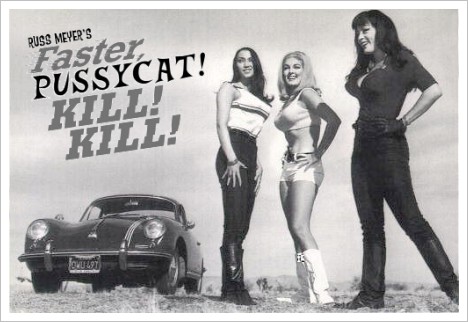Ten Essential, Timeless Female Teams in the Movies
Director Alex Garland’s new science fiction thriller, “Annihilation”, invades theatres on Friday Feb. 23, as five armed women accept a mission to step into a bizarre, unknown phenomenon called The Shimmer which changes an ordinary American marshland into something else. Natalie Portman, Jennifer Jason Leigh, Tessa Thompson, Gina Rodriguez, and Tuva Novotny play the women from the aforementioned group, and their work in this film certainly adds to the rich history of great female on-screen teams and duos throughout the decades. Well, looking back through movie history, here are my picks for 10 essential and timeless ones.
Jess Bhamra, Juliette Paxton and the Hounslow Harriers - “Bend It Like Beckham” (2002) – Juliette (Keira Knightley) encourages Jess (Parminder Nagra) to step out of her comfort zone and play for an all-girls English football team. The problem is that Jess’s parents are far more uncomfortable with this proposition, as this fun and inspiring comedy embraces family, friends and chasing one’s dreams. Director Gurinder Chadha offers a refreshing look into East Indian culture and treats the characters and customs with grace, including a skillful blend of choreography between a traditional wedding and movement on the pitch in the rousing third act. Nagra and Knightley display plenty of ample football skills too, but the film devotes more time to their off-field stories. Be on the lookout for Anupam Kher, who also plays Azmat (the father) in 2017’s “The Big Sick”.
Varla, Rosie and Billie - “Faster, Pussycat! Kill! Kill!” (1965) – “Ladies and Gentlemen, welcome to violence.” Those words start director Russ Meyer’s 1-hour 23-minute foray into Varla’s (Tura Satana), Rosie’s (Haji) and Billie’s (Lori Williams) odd, twisted journey in the California desert. Varla, a relentless instigator, leads this trio into trouble, including verbal and physical spats with an All-American couple and a half-baked plot to steal from an old man and his grown boys. With heaps of an unapologetic, counterculture style and a cartoonish figure, Varla’s live fast, tough girl persona is only matched by her metaphorical speech. Hey, Daddy-o, there ain’t nothin’ pleasant about this movie, but it’s a crazy, low-budget ride, Man.
Dorothy Shaw and Lorelei Lee – “Gentlemen Prefer Blondes” (1953) – Dorothy (Jane Russell) and Lorelei (Marilyn Monroe) work as a lounge/club act, and exclaim – in song – that they are two girls from Little Rock. Well, from Little Rock or not, they end up on a cruise ship heading for France in a breezy comedy, in which these two legendary heroines absolutely shine. Russell and Monroe play polar opposites, as Dorothy’s pragmatism creates hilarious semi-combustible exchanges with the starry-eyed Lorelei who searches high and low for a millionaire to shower her with diamonds. Actually, she doesn’t have to look terribly far, and the film features Monroe’s iconic delivery of “Diamonds are a Girl’s Best Friend”. That same year, Monroe, Betty Grable and Lauren Bacall starred in “How to Marry a Millionaire”, and their three characters had a more focused goal as a team, but “Gentlemen Prefer Blondes” is a better movie.
Katherine G. Johnson, Dorothy Vaughan and Mary Jackson - “Hidden Figures” (2016) – When walking on the moon in 1969, Neil Armstrong said, “One small step for (a) man, one giant leap for mankind,” but three African-American women made giant leaps of their own at NASA, beginning in 1961. Based on the true story, Taraji P. Henson, Octavia Spencer and Janelle Monae play mathematicians Katherine G. Johnson, Dorothy Vaughn and Mary Jackson, as these three women help trailblaze the way for civil rights with their outstanding contributions at the nation’s leading space center. Director Theodore Melfi and the actresses emote the women’s struggles against institutional racism and related setbacks, along with their forward-thinking ingenuity, led by Johnson who is the lone black woman on Al Harrison’s (Kevin Costner) high profile team. This inspiring film – nominated for three Oscars, including Best Picture - flies with all the right beats and reaches for – and catches - the stars.
Dottie Hinson, Kit Keller and the Rockford Peaches - “A League of Their Own” (1992) – World War II called a nation of young American men to duty, including baseball players. This, however, did not prevent sports fans from watching professional baseball, because a collection owners and female athletes formed the All-American Girls Professional Baseball League in 1943. In a dramatized story about a real baseball league, the talented cast - led by Geena Davis, Lori Petty, Rosie O’Donnell, Madonna - showcase the competitive spirit and fun of America’s pastime in, arguably, the most celebrated female sports film in movie history. Not only does director Penny Marshall offer some hilarious moments from the tough-as-nails duo of Doris (O’Donnell) and Mae (Madonna), the Rockford Peaches head coach (Tom Hanks) and lead scout (Jon Lovitz), but she does not shy away from revealing the sexism that the Peaches endured, along with game time dramatics and tension between sisters Dottie (Davis) and Kit (Petty). All the on and off-field moments feel earnest and authentic, and when the movie ends, you will declare, “We need a sequel. Let’s play two!”
Annie Sullivan and Helen Keller – “The Miracle Worker” (1962) – Annie (Anne Bancroft) and Helen (Patty Duke) do not really work well as a teacher-student team. Quite the opposite, actually. Six-year-old Helen is blind and deaf, and she physically and emotionally resists Annie’s persistent attempts to communicate with her. Their struggle pours off the screen and douses the viewer with anxiety for a majority the film’s 1 hour and 46 minutes, as Annie truly needs to become a miracle worker to explain words, concepts and very basic manners to a lost child with no palatable points of reference. Quite frankly, the exhausting, 10-minute dining room table scene alone should garner Annie a medal. Well, the Academy certainly noticed, because Bancroft and Duke won the Best Actress and Best Supporting Actress Oscars in 1963. This film depicts a portion of Helen’s real-life story, and she went on to earn a Bachelor of Arts degree, so yes, Annie Sullivan and Helen are both miracle workers.
Lale, Nur, Selma, Ece, and Sonay – “Mustang” (2015) – Raised by their grandmother, five sisters (played by Gunes Sensoy, Doga Zeynep Doguslu, Tugba Sunguroglu, Elit Iscan, and Ilayda Akdogan) harmless play in the Black Sea with some boys, but their uncle responds with massively excessive repercussions in a movie which intimately captures the struggle between child and adult and freedom of expression versus oppression more than any other film in recent memory. The girls respond to their repressive new environment in varying ways, while writer/director Deniz Gamze Erguven organically communicates the involved bonds of sisterhood and heartbreaking moments within figurative and literal enclosed spaces. The Academy rightly nominated “Mustang” for the Best Foreign Language Film of the year.
Judy Bernly, Violet Newstead and Doralee Rhodes – “9 to 5” (1980) – “The Empire Strikes Back” was 1980’s highest grossing movie, but “9 to 5” – which addresses unfair workplaces for women in a comedic and empowering way – was the second highest. In the film, Judy (Jane Fonda), Violet (Lily Tomlin) and Doralee (Dolly Parton) plot against their boss, Franklin Hart (Dabney Coleman), after years of his repeated sexist slights. All three leads are especially good and very likable, and Fonda delivers the biggest surprise with her understated performance. The film struck a chord with audiences, especially women impacted by discriminating office environments of their own, and one can only imagine theatres bursting into laughter and emotional release, when Doralee threatens Mr. Hart by saying, “I’m gonna get that gun of mine and change you from a rooster to a hen in one shot.”
Elinor, Marianne, Margaret, and Mother Dashwood – “Sense and Sensibility” (1995) – Due to British legal complications, Mr. Dashwood’s (Tom Wilkinson) estate is passed to his male son from his first marriage and not to his wife (Gemma Jones) and daughters (Emma Thompson, Kate Winslet and Emile Francois) from his second. For the Dashwood women, in addition to missing their late husband/father, they also lost their financial comforts. In director Ang Lee’s adaption of Jane Austin’s novel, the four women rally together and support one another, despite their dissimilar personalities, especially between the reserved Elinor (Thompson) and idealistic Marianne (Winslet). Displaced to a cottage in the country, the film basks in topnotch performances and a tightrope act of finding love, when pleasantries, obligations and duties usually trump passion. Nominated for seven Oscars – including Thompson and Winslet for Best Actress and Best Supporting Actress, respectively – it makes perfect sense to embrace this picture again, 23 years after its initial release.
Thelma Dickinson and Louise Sawyer - “Thelma & Louise” (1991) – Thelma (Geena Davis) and Louise (Susan Sarandon) embark on a weekend road trip, and their travels begin extremely well, as they smile and sing “The way you do the things you do” in a green Thunderbird convertible. On the first evening of their vacation, however, they suddenly begin humming an extremely different tune, because misfortune and bad judgment collide with their previously-merry plan. Director Ridley Scott, Davis and Sarandon capture a transformational journey with these two women, who have been living with chauvinism and economic oppression that they release on the road in the American desert. Nominated for six Oscars, including two Best Actress nominations for Davis and Sarandon, this film moves the needle on female empowerment, because Thelma’s and Louise’s methods do not abide by traditional manners.
Jeff – a member of the Phoenix Critics Circle – has penned film reviews since 2008 and graduated from ASU’s Walter Cronkite School of Journalism. Follow Jeff and the Phoenix Film Festival on Twitter @MitchFilmCritic and @PhoenixFilmFest, respectively.




















